To view previous releases, select one from the dropdown box:
Currently displaying information released on: July, 2017
ANALYSIS OF NOVA SCOTIA'S CONSUMER PRICE INDEX FOR JUNE 2017
In Nova Scotia June 2017, annual consumer price inflation (year-over-year growth) was 0.5 per cent, below the national average of 1.0 per cent. Monthly consumer prices increased 0.2 per cent in Nova Scotia, while nationally prices decreased 0.1 per cent.
Within Atlantic Canada, New Brunswick (+2.0 per cent) and Newfoundland and Labrador (+1.5%) had the highest annual inflation compared with Prince Edward Island (+1.2 per cent) and Nova Scotia (+0.5 per cent). On July 1, 2016, the provincial component of the harmonized sales tax (HST) increased in both Newfoundland and Labrador and New Brunswick. In Prince Edward Island, the provincial component of the HST was increased effective October 1, 2016.
All other provinces experienced positive annual inflation in June.
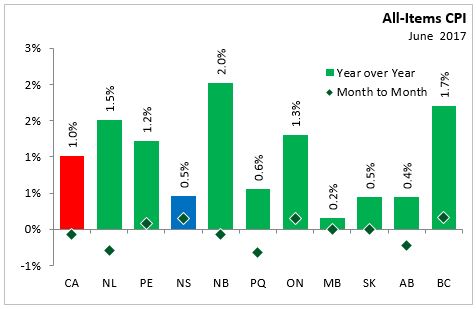
Nova Scotia's annual consumer price inflation (year over year growth in CPI) excluding food and energy rose 0.9 per cent in June, below the national rate of 1.4 per cent. Price level gains for this index were largest in New Brunswick (+2.7 per cent) and Newfoundland and Labrador (+3.3 per cent), and lowest in Quebec (+0.5 per cent). On a monthly basis, Nova Scotia's index excluding food and energy increased 0.2 per cent.
The main contributors to the monthly (June 2017 vs. May 2017) NS CPI movement:
Traveller Accommodation (+9.0%)
Telephone services (+1.9%)
Gasoline (-2.6%)
Men's clothing (-6.4%)
The main contributors to the annual (June 2017 vs. June 2016) NS CPI movement:
Fuel oil and other fuels (+8.3%)
Food purchased from restaurants (+2.4%)
Non-alcoholic beverages (-18.2%)
Fresh or Frozen Beef (-15.2%)
The CPI for food in Nova Scotia declined 2.3 per cent year-over-year with a 0.5 per cent increase month-over-month. CPI growth in food (year over year) declined in all provinces except in Quebec, Ontario, Saskatchewan, Alberta and BC. Nationally, annual food prices increased 0.6 per cent.
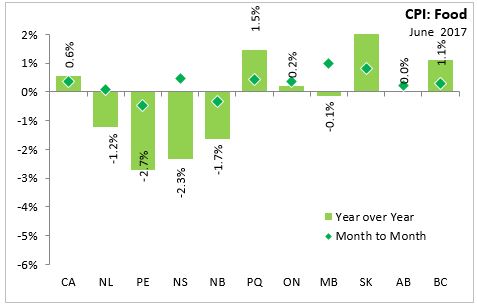
The Nova Scotia energy index increased by 1.4 per cent compared to a year ago. Energy prices were lower in five provinces compared to a year ago and nationally fell 1.3 per cent. Energy prices saw the largest increase in British Columbia (+4.1 per cent).
Major Components for June 2017
The following table shows the price increases specific to Nova Scotia for the major components of the CPI this month: 
Long Run Trends
The All-Items CPI annual inflation rate for Nova Scotia was below Canada's in June 2017. Since June 2014, Nova Scotia's annual inflation has been below the Canadian average except for three months in 2016: January, September and November. While month to month movements in the indices can be different, over time they generally follow the same overall trend.

Annual inflation for the CPI excluding food and energy was lower for Nova Scotia (+0.9 per cent) than for Canada (+1.4 per cent).
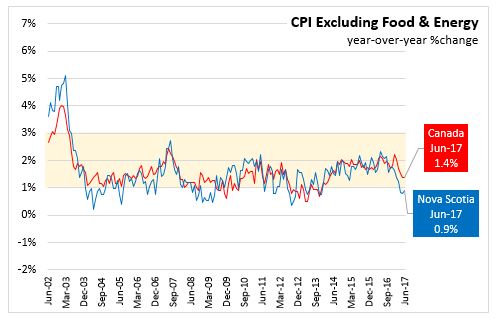
Bank of Canada's preferred measures of core inflation
Compared with June 2016, CPI-Common rose 1.4 per, CPI-Median rose 1.6 per cent, and CPI-Trim rose 1.2 per cent in Canada. All-items CPI excluding eight of the most volatile components as defined by the Bank of Canada and excluding the effect of changes in indirect taxes (formerly referred to as CPIX) rose 0.9 per cent year over year in June 2017.
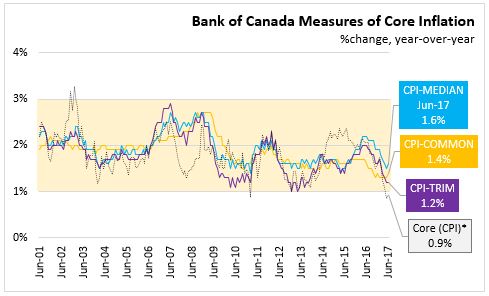
Appendix Tables
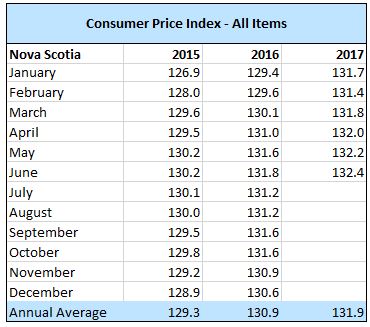

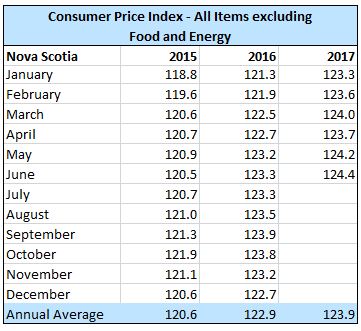

Source: Statistics Canada CANSIM Tables 326-0020 , 326-0023 CONSUMER PRICE INDEX JUNE 2017
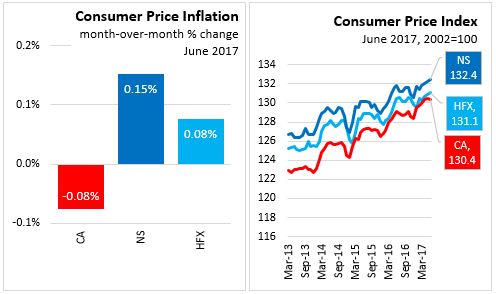
NOVA SCOTIA
In Nova Scotia June 2017, the consumer price index (2002=100) increased 0.2% from May 2017 to 132.4 and increased 0.5% over June 2016.
The CPI, excluding food and energy, increased 0.2% from May 2017 to 124.4, and increased 0.9% over June 2016.
CANADA
In Canada June 2017, the consumer price index (2002=100) decreased 0.1% from May 2017 to 130.4 and increased 1.0% over June 2016.
The CPI, excluding food and energy, increased 0.1% from May 2017 to 125.6, and increased 1.4% over June 2016.
Compared with June 2016, CPI-Common rose 1.4%, CPI-Median rose 1.6%, and CPI-Trim rose 1.2%.
HALIFAX
In Halifax June 2017, the consumer price index (2002=100) increased 0.1% from May 2017 to 131.2 and increased 0.5% over June 2016.
Statistics Canada Quote:
"Consumer prices rose less on a year-over-year basis in nine provinces in June than they did in May. The 12-month increase in the CPI in Nova Scotia was unchanged from a month earlier."
Statistics Canada Note: Since 2001, the Bank of Canada's main measure of core inflation has been "core" consumer price index (CPIX) inflation, which excludes eight of the most volatile components of the CPI and adjusts the remainder for the effect of changes in indirect taxes. Following a review of a wide selection of measures of core inflation in 2015, in the context of its most recent renewal of the inflation-control target, the Bank chose three preferred measures of core inflation: (i) a measure based on a trimmed mean (CPI-trim); (ii) a measure based on the weighted median (CPI-median); (iii) a measure based on the common component (CPI-common). For more information see The Daily.
Statistics Canada Cat. No. 62-001, CANSIM 326-0020 326-0023 EU AND EURO AREA CONSUMER PRICE INFLATION, JUNE 2017
In June, annual inflation was 1.3 per cent in the Euro Area and 1.4 per cent in the European Union, both decreases compared to last month. In May, annual inflation was 1.4 per cent in the Euro Area and 1.6 per cent in the EU. In June 2016, inflation in both the Euro Area and the EU was 0.1 per cent.
The highest annual rates were recorded in Estonia (3.1%), Lithuania (3.5%), and Latvia (3.1%). The lowest rates were registered in Ireland(-0.6%), Romania (0.7%), and Denmark (0.4%)
The largest upward impacts to euro area annual inflation came from package holidays, accommodations services, and tobacco. Telecommunication, bread and cereals, and social protection had the biggest downward impacts.
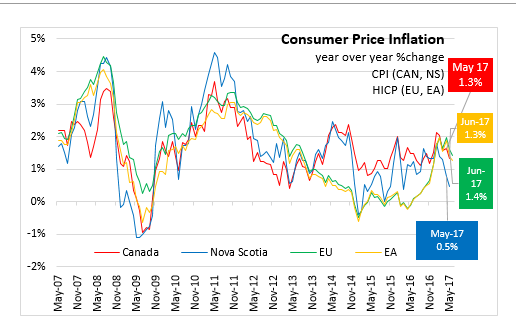
Source: Eurostat
|